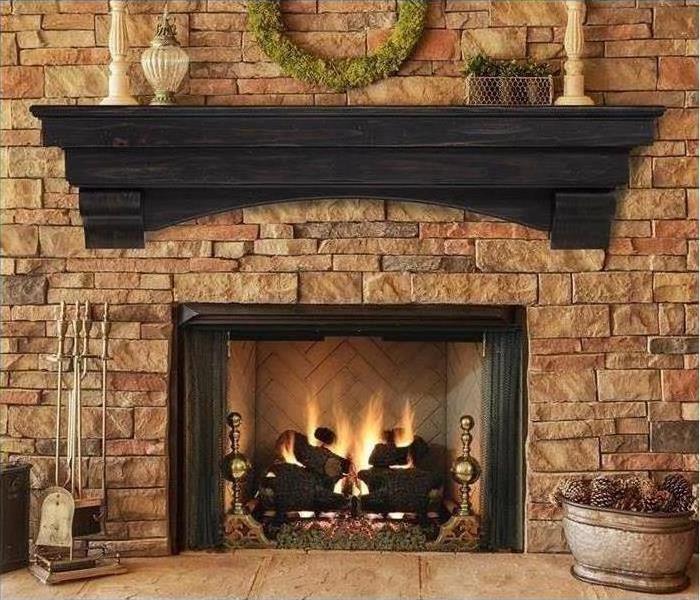Fireplace on Valentine's Day Safety Crash Course
1/31/2022 (Permalink)
 There’s something magical about the crackling sounds and dancing, the soft light of a fire on a chilly February evening.
There’s something magical about the crackling sounds and dancing, the soft light of a fire on a chilly February evening.
There’s no arguing that a fireplace is the perfect romantic complement to any Valentine’s Day evening. There’s something magical about the crackling sounds and dancing, soft light of a fire on a chilly February evening. A poorly maintained fireplace can turn that sense of romance into one of terror if it causes the fire to spread. So this Valentine’s day, before you start that fire and sit by the hearth with someone special, take a moment to go over these tips to make sure your home is safe.
- Have your fireplace cleaned and inspected regularly
According to the National Fire Protection Association, 28 percent of heating fires are caused by failing to clean equipment, especially chimneys. Over time, creosote (a sticky, flammable substance that’s released when wood’s burned) can build up in the chimney. If the creosote isn’t removed, a chimney fire can result. This is not only dangerous in itself, but it can also cause damage to the chimney, increasing the risk that flames will reach the frame of the house.
Debris such as fallen leaves and animal nests should also be removed since they can restrict airflow and cause carbon monoxide to back up into the house.
If you have a wood-burning fireplace or stove, you should have the chimney professionally inspected at least once a year (before you use it). Ask for a Level 1 inspection, which involves a visual examination of readily accessible parts of the chimney. The inspector will ensure the chimney is sturdy and perform any necessary cleaning.
Have a gas fireplace instead of a wood-burning one? You should still get a regular inspection, as corrosive deposits can build up and prevent your fireplace from venting efficiently. Debris can block this type of chimney as well.
- Burn only dry, seasoned wood
Properly seasoned firewood contains around 20 percent water. Freshly cut wood can contain up to 45 percent water, so it takes a lot of heat to get it to catch fire (which means less heat inside your house). Burning wet wood also creates large amounts of smoke and causes creosote to build up more rapidly.
To be properly seasoned, firewood must be cut to length and allowed to dry for at least 6 months (up to a year in damp climates) before being burned. If you’ve gathered a stockpile of wood, be sure to protect it from rain and snow. If you’re buying wood to burn, look for dark edges with visible cracks. Well-seasoned firewood’s fairly lightweight and makes a clear, sharp sound when clapped together.
Resist the temptation to toss wrapping paper, cardboard boxes, or foam containers into the fireplace. Paper and cardboard can cause flames to burn too high, while foam releases toxic smoke and particles into the air.
- Make sure your damper’s properly adjusted
The fireplace damper is a plate or valve that controls airflow in your chimney. When the fireplace isn’t in use, keep the damper closed completely to prevent heat from escaping. When lighting the fire, open the damper wide to help create a good blaze and get smoke flowing up the chimney. Once the fire’s burning well, partially close the damper to keep in warmth while still allowing smoke to escape.
- Install and regularly check carbon monoxide detectors
Burning wood creates carbon monoxide (a poisonous gas) — but this poses little danger if your chimney’s properly maintained and free from obstructions and if your damper’s letting smoke out. Nonetheless, it’s wise to install smoke and carbon monoxide detectors close to your fireplace as well as in your bedrooms.
In the event that you do have fire damage, it is best to know what the proper steps are to take in the situation to avoid further damage to your home. Take a look at the SERVPRO Fire Damage Restoration Process:
Our Fire Damage Restoration Services
Since each smoke and fire damage situation is a little different, each one requires a unique solution tailored for the specific conditions. When various materials burn, the soot and residue they create differ greatly and require a specific cleaning procedure. The steps listed below illustrate our process for the “typical” fire damage restoration. Learn more about our fire damage restoration process.
- Emergency Contact
- Inspection and Fire Damage Assessment
- Immediate Board-Up and Roof-Tarp Service (if needed)
- Water Removal and Drying (if water damage is present)
- Removal of Smoke and Soot from All Surfaces
- Cleaning and Repair
- Restoration
For more information on what steps you should take to begin the Fire Damage Restoration process and what SERVPRO of
Tarrytown/Elmsford can do for you, take a look at our website here.
Have Questions about Fire, Smoke, or Soot Damage? Call us today at (914)358-9000!
Sources:
www.SERVPROoftarrytownelmsford.com
http://blog.esurance.com/4-must-read-tips-for-fireplace-safety/#.Vri1T_krKM8






 24/7 Emergency Service
24/7 Emergency Service